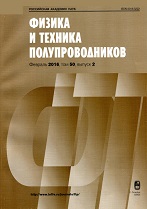|
|
Fizika i Tekhnika Poluprovodnikov, 2016, Volume 50, Issue 2, Pages 274–278
(Mi phts6552)
|
 |
|
 |
This article is cited in 7 scientific papers (total in 7 papers)
Manufacturing, processing, testing of materials and structures
Layer-by-layer composition and structure of silicon subjected to combined gallium and nitrogen ion implantation for the ion synthesis of gallium nitride
D. S. Koroleva, A. N. Mikhaylova, A. I. Belova, V. K. Vasil'eva, D. V. Guseinova, E. V. Okulicha, A. A. Shemukhinb, S. I. Surodina, D. E. Nikolicheva, A. V. Nezhdanova, A. V. Pirogova, D. A. Pavlova, D. I. Tetelbauma
a Lobachevsky State University of Nizhny Novgorod
b Lomonosov Moscow State University, Skobeltsyn Institute of Nuclear Physics
Abstract:
The composition and structure of silicon surface layers subjected to combined gallium and nitrogen ion implantation with subsequent annealing have been studied by the X-ray photoelectron spectroscopy, Rutherford backscattering, electron spin resonance, Raman spectroscopy, and transmission electron microscopy techniques. A slight redistribution of the implanted atoms before annealing and their substantial migration towards the surface during annealing depending on the sequence of implantations are observed. It is found that about 2% of atoms of the implanted layer are replaced with gallium bonded to nitrogen; however, it is impossible to detect the gallium-nitride phase. At the same time, gallium-enriched inclusions containing $\sim$25 at % of gallium are detected as candidates for the further synthesis of gallium-nitride inclusions.
Keywords:
Gallium, Annealing Atmosphere, Inverse Sequence, SRIM Software, SRIM Calculation.
Received: 28.05.2015
Accepted: 15.06.2015
Citation:
D. S. Korolev, A. N. Mikhaylov, A. I. Belov, V. K. Vasil'ev, D. V. Guseinov, E. V. Okulich, A. A. Shemukhin, S. I. Surodin, D. E. Nikolichev, A. V. Nezhdanov, A. V. Pirogov, D. A. Pavlov, D. I. Tetelbaum, “Layer-by-layer composition and structure of silicon subjected to combined gallium and nitrogen ion implantation for the ion synthesis of gallium nitride”, Fizika i Tekhnika Poluprovodnikov, 50:2 (2016), 274–278; Semiconductors, 50:2 (2016), 271–275
Linking options:
https://www.mathnet.ru/eng/phts6552 https://www.mathnet.ru/eng/phts/v50/i2/p274
|


| Statistics & downloads: |
| Abstract page: | 46 | | Full-text PDF : | 15 |
|





 Contact us:
Contact us: Terms of Use
Terms of Use
 Registration to the website
Registration to the website Logotypes
Logotypes








 Citation in format
Citation in format 
